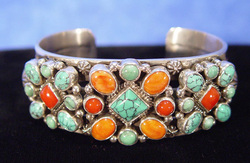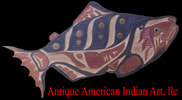Learn About the Art > About Contemporary Native American Jewelry
About Contemporary Native American Jewelry

One of the more popular Native American art forms on today's market is
contemporary jewelry.
What makes contemporary Native American Jewelry so popular?
1. Native American Jewelry is Accessible
Contemporary American Indian Southwestern jewelry has enjoyed a long-running popularity due to the handsome nature and compelling ethnic quality of the work, the relatively modest price points compared with most fine jewelry (which translates into "good value" for the buyer), and to the skill and artistry of native jewelers and silversmiths themselves. Take a trip to Arizona and New Mexico for example and you will commonly find contemporary Native jewelry in shops, airports and galleries. Venture online and search for American Indian jewelry and your choices may seem limitless. (Though beware, in both situations you'll want to deal only with reputable dealers who know their inventory and ask honest prices). For nearly 150 years, silver and turquoise jewelry has proven to be extremely resilient to the changing markets and technologies, and has been supported by natives and Indian art dealers as both an art form and product for trade.
2. Native American Jewelry is Wearable
Created in nearly every size imaginable, Native American jewelry can fit on anyone, and can be worn for any occasion. Jewelry hand-crafted by natives today is commonly sized for infants, children, teenagers and adults of all sizes and shapes. The styles range from simple designs to very complex and ornate creations, and are appropriate for both informal (daily) and formal (special occasions) situations. Native jewelry can be enjoyed by everyone, and worn as often as one desires.
3. Native American Jewelry is Personal in Expression
Traditionally, Navajo Indian jewelry takes after the Navajo cultural spirit, and is bold in nature, featuring larger stone settings and deep stamp work. The Zuni tradition is known for fine stone work; small settings such as needlepoint and petit-point or more intricate stone inlay within Sterling Silver channels or within a mosaic framework, all of which express a more delicate or sometime ornate aesthetic. The people of Santo Domingo Pueblo traditionally create jewelry in mosaic inlay, involving multiple stones or shells cut and placed in mosaic fashion on top of another layer of stone or shell. The Hopi Indians of Arizona produce stunning Sterling Silver overlay jewelry, in which one layer of Sterling silver is hand-sawn and soldered onto another “background” layer of Sterling silver.
Each of these approaches to jewelry-making result in different aesthetics or “looks.” Consequently, the wearer of Native American jewelry can make a personal statement, be it privately or publicly, when choosing to wear a particular jewelry item. Whether you are timid or outgoing, meticulous or easy-going, there is a style for you in Native American jewelry.
All of our Contemporary Native American jewelry items are 100% authentic and hand-made. Since 1969, we have been sharing the stories and the history of American Indian silversmithing and jewelry making. We would be thrilled to discuss any of our jewelry pieces with you, personally, today.
To see our Contemporary Indian Jewelry for sale online, please click here.
What makes contemporary Native American Jewelry so popular?
1. Native American Jewelry is Accessible
Contemporary American Indian Southwestern jewelry has enjoyed a long-running popularity due to the handsome nature and compelling ethnic quality of the work, the relatively modest price points compared with most fine jewelry (which translates into "good value" for the buyer), and to the skill and artistry of native jewelers and silversmiths themselves. Take a trip to Arizona and New Mexico for example and you will commonly find contemporary Native jewelry in shops, airports and galleries. Venture online and search for American Indian jewelry and your choices may seem limitless. (Though beware, in both situations you'll want to deal only with reputable dealers who know their inventory and ask honest prices). For nearly 150 years, silver and turquoise jewelry has proven to be extremely resilient to the changing markets and technologies, and has been supported by natives and Indian art dealers as both an art form and product for trade.
2. Native American Jewelry is Wearable
Created in nearly every size imaginable, Native American jewelry can fit on anyone, and can be worn for any occasion. Jewelry hand-crafted by natives today is commonly sized for infants, children, teenagers and adults of all sizes and shapes. The styles range from simple designs to very complex and ornate creations, and are appropriate for both informal (daily) and formal (special occasions) situations. Native jewelry can be enjoyed by everyone, and worn as often as one desires.
3. Native American Jewelry is Personal in Expression
Traditionally, Navajo Indian jewelry takes after the Navajo cultural spirit, and is bold in nature, featuring larger stone settings and deep stamp work. The Zuni tradition is known for fine stone work; small settings such as needlepoint and petit-point or more intricate stone inlay within Sterling Silver channels or within a mosaic framework, all of which express a more delicate or sometime ornate aesthetic. The people of Santo Domingo Pueblo traditionally create jewelry in mosaic inlay, involving multiple stones or shells cut and placed in mosaic fashion on top of another layer of stone or shell. The Hopi Indians of Arizona produce stunning Sterling Silver overlay jewelry, in which one layer of Sterling silver is hand-sawn and soldered onto another “background” layer of Sterling silver.
Each of these approaches to jewelry-making result in different aesthetics or “looks.” Consequently, the wearer of Native American jewelry can make a personal statement, be it privately or publicly, when choosing to wear a particular jewelry item. Whether you are timid or outgoing, meticulous or easy-going, there is a style for you in Native American jewelry.
All of our Contemporary Native American jewelry items are 100% authentic and hand-made. Since 1969, we have been sharing the stories and the history of American Indian silversmithing and jewelry making. We would be thrilled to discuss any of our jewelry pieces with you, personally, today.
To see our Contemporary Indian Jewelry for sale online, please click here.
